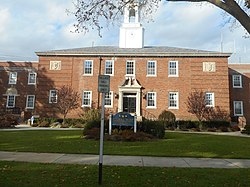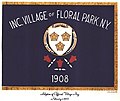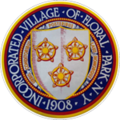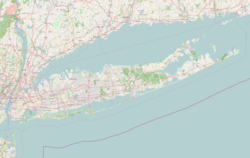Floral Park, New York | |
|---|---|
| Incorporated Village of Floral Park | |
 Floral Park Village Hall in 2017 | |
| Motto: "A Great Place to Live" | |
 Location in Nassau County and the state of New York | |
| Coordinates: 40°43′26″N73°42′21″W / 40.72389°N 73.70583°W | |
| Country | |
| State | |
| County | Nassau |
| Town | Hempstead North Hempstead |
| Founded | 1874 [1] |
| Incorporated | 1908 |
| Founded by | John Lewis Childs |
| Government | |
| • Type | Strong Mayor-Council |
| • Mayor | Kevin Fitzgerald |
| Area | |
• Total | 1.44 sq mi (3.72 km2) |
| • Land | 1.42 sq mi (3.68 km2) |
| • Water | 0.012 sq mi (0.03 km2) |
| Elevation | 92 ft (28 m) |
| Population (2020) | |
• Total | 16,172 |
| • Density | 11,381/sq mi (4,394.2/km2) |
| Time zone | UTC-5 (EST) |
| • Summer (DST) | UTC-4 (EDT) |
| ZIP Codes | 11001, 11004 |
| Area codes | 516, 363 |
| FIPS code | 36-26264 |
| GNIS feature ID | 0950296 |
| Website | www |
Floral Park is an incorporated village located in western Nassau County, on Long Island, in New York, United States. The population was 16,172 at the time of the 2020 census.
Contents
- History
- Geography
- Drainage
- Climate
- Demographics
- 2020 census
- 2010 census
- 2000 census
- Education
- Emergency services
- Notable people
- Adjacent Queens neighborhood
- See also
- References
- External links
Floral Park is at the western border of Nassau County, mainly in the Town of Hempstead, while the section north of Jericho Turnpike (NY 25) is within the Town of North Hempstead. The area was formerly known as East Hinsdale.
The neighborhood of Floral Park in the New York City borough of Queens is adjacent to – but not part of – the village.







